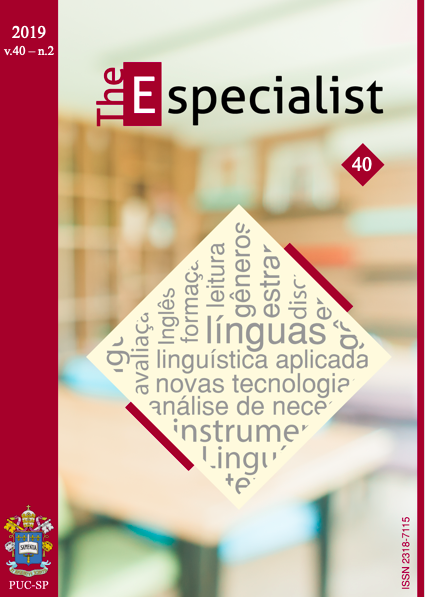The role of the active learning approach in teaching English as a foreign language
DOI:
https://doi.org/10.23925/2318-7115.2019v40i2a10Palavras-chave:
Active Learning, Autonomy, EFL teaching.Resumo
This study aimed at elucidating what the Active Learning Approach (AL) is and determining its role in the teaching and learning of English as a foreign language, proposing, therefore, some activities that follow this perspective of knowledge construction. In order to reach the proposed objective, an extensive review of the literature was conducted. Overall, the proposed activities following AL have the potential to regain students’ interest in learning, because it is a student-centered approach and its main objective is to promote autonomy and engagement in the learning process. Moreover, the AL Approach has proved to be a powerful tool when teaching and learning English as a foreign language. This is due to its capability of promoting a more independent learning, and consequently, helping the student to develop more efficiently the abilities needed to communicate in a new language. Having that in mind, we proposed seven activities, using active learning techniques, such as portfolios, discussion in class, projects, visual-based instruction, flipping the lesson, debate as a learning activity, and think-pair-share. Such activities were designed for A2 (basic) and B1 (intermediate) learners according to the Common European Framework of Reference for Languages.
Referências
ANTHONY, E. 1963. Approach, method, and technique. ELT Journal, Michigan v. XVII: 63–67.
BANCROFT, J. 1999. Suggestopedia and language acquisition: variations on a theme. Toronto: Gordon and Breach.
BELL, D.; KAHRHOFF, J. 2006. Active learning handbook. St. Louis: Webster University.
BERGMANN, J.; SAMS, A. 2012. Flip your classroom: reach every student in every class every day. Alexandria: ASCD.
GUTIÉRREZ BERMÚDEZ, J. F. 2014. An exercise in course-book evaluation: Strengths, weaknesses and recommendations regarding New English file: Elementary. Latin American Journal of Content and Language Integrated Learning, 7.1: 98–111.
BONWELL, C. C.; EISON, J. A. 1991. Active learning: creating excitment in the classroom. Washington DC: ASHE-ERIC Higher Education Reports.
BRANSFORD, J. B.; COCKING, R. 1999. How people learn: brain, mind, experience, and school. Washington DC: National Academy Press.
CELCE-MURCIA, M. 2001. Teaching English as a second or foreign language. 3rd. ed. Boston, MA: Heinle & Heinle.
CHOWDHURY, F. 2016. Employment of Active Learning at HEIs in Bangladesh to improve education quality. 11 p. Article (Faculty of Business Administration)- American International University-Bangladesh, Dhaka. Available at: <https://files.eric.ed.gov/fulltext/EJ1115992.pdf>. Access on: 15 Oct. 2018.
DEWEY, J. 1924. Democracy and education. New York: The Macmillan Company. Available at: <http://www.gutenberg.org/files/852/852-h/852-h.htm>. Access on: 01 Apr. 2018.
EYRING, J. 2001. Experiential and negociated language learning. In: CELCE-MURCIA, Marianne. Teaching English as a second or foreign language. Boston, Heinle & Heinle. pp. 333-344.
FELTES, H. P. M. 2014. Cognição e metacognição: aplicação em uma atividade psicolinguística com Teste Cloze. In: PELOSI, A. C.; FELTES, H. P. M.; FARIAS, E. M. P. (Org.). Cognição e linguística: explorando territórios, mapeamentos e percursos. 2nd. ed. Caxias do Sul: Educs. pp. 171-195.
FREIRE, P. 1970. Pedagogia do oprimido. São Paulo: Paz e Terra.
_______, P.; MACEDO, D. 1987. Literacy: reading the word and the world. London: Routledge.
LARSEN-FREEMAN, D. 2000. Techniques and principles in language teaching. Oxford: Oxford University Press.
LINDSAY, C.; KNIGHT, P. 2006. Learning and teaching English: a course for teachers. Oxford: Oxford University Press.
MATSUSHITA, K. 2015. Deep Active Learning: toward greater depth in university education. Kyoto: Springer.
MELLO, G. N. 1991. Políticas públicas de educação. Estudos Avançados 5. 13: 7-47.
OXENDEN, C.; LATHAM-KOENIG, C.; SELIGSON, P. 2008. American English File 1. Oxford: Oxford University Press.
______. 2008. American English File 3. Oxford: Oxford University Press.
PIAGET, J. 1973. To understand is to invent: the future of the education. New York: Grossman Publishers.
PRINCE, M. Does active learning work?: a review of the research. Available at: <https://onlinelibrary.wiley.com/doi/abs/10.1002/j.2168-9830.2004.tb00809.x>. Access on: 01 May 2018.
RICHARDS, J. C.; RODGERS, T. S. 2001. Approaches and methods in language teaching. 2. ed. Cambridge: Cambridge University Press.
SAVIGNON, S. J. 2001. Communicative language teaching for the twenty-first century. In: CELCE-MURCIA, M. (Ed.). Teaching English as a second or foreign language. Boston, Heinle & Heinle. pp. 12-28.
SAYLOR, M. M.; GANEA, P. A. 2018. Active Learning from infancy to childhood: social motivation, cognition, and linguistic mechanisms. Switzerland: Springer.
TAN, O-S. 2004. Enhancing thinking through problem-based learning approaches: international perspectives. Singapore: Cengage Learning.
WILLIAMS, Phil. 2013. Best textbook for English classes? New English File review. Available at: http://www.englishlessonsbrighton.co.uk/best-textbook-classes-new-english-file-review/. Access on: 4 May 2018.
WRIGHT, D. E. 2015. Active Learning: social justice education and participatory action research. New York: Routledge.
Downloads
Publicado
Como Citar
Edição
Seção
Licença
Os autores concedem à revista todos os direitos autorais referentes aos trabalhos publicados. Os conceitos emitidos em artigos assinados são de absoluta e exclusiva responsabilidade de seus autores.


 Esta obra está licenciada com uma Licença
Esta obra está licenciada com uma Licença 

